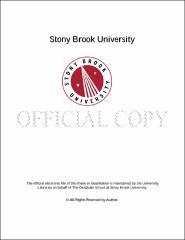| dc.identifier.uri | http://hdl.handle.net/11401/78324 | |
| dc.description.sponsorship | This work is sponsored by the Stony Brook University Graduate School in compliance with the requirements for completion of degree | en_US |
| dc.format | Monograph | |
| dc.format.medium | Electronic Resource | en_US |
| dc.format.mimetype | Application/PDF | en_US |
| dc.language.iso | en_US | |
| dc.type | Thesis | |
| dcterms.abstract | The largest source of uncertainty in current climate models is found in the contribution of aerosol particles, which have both cooling and warming effects. Of this uncertainty, a significant fraction is due to an incomplete understanding of new particle formation, in which aerosols are formed directly from atmospheric trace vapor. Advances will require the development of a mechanistic framework describing the structures and thermodynamics of growth. Cluster size and composition can often be determined from fieldwork, but laboratory work must be done to determine energetics and structure. A major current focus of studies on new particle formation involves clusters of sulfuric acid and ammonia, and exchange of ammonia for amines. This work presents studies laying the groundwork for the development of a mechanism describing ammonia-amine exchange. Clusters containing sulfuric acid and ammonia—both cationic and anionic—were formed via electrospray ionization, and cluster composition patterns were investigated through mass spectrometry. A major goal was to develop a rational approach to synthesizing clusters with specific compositions. Methylamine, dimethylamine, and trimethylamine can be straightforwardly substituted into the clusters. Structures of small cationic clusters of these compositions were investigated using cryogenic ion vibrational predissociation spectroscopy experiments to determine structural trends. It is not enough to just be able to elucidate the structures of these clusters. Reactions occur in the atmosphere, and it would be useful to model those as well through thermochemistry. Temperature-controlled ion traps are being constructed to carry out these thermochemical measurements. Temperature could be a major source of uncertainty in these measurements, so experiments to determine the effective temperature of the ions in relation to the temperature of the trap were begun. Current work uses a cryogenic trap (~3.5–300K) and the ammonium-water binary system as a model. In these experiments, the temperature of the ion trap was varied and the temperature of the ions was determined by fitting the rovibrational features of the nearly-free water rotor. Results show that the derived temperature does indeed respond to changes in trap temperature, but that several challenges remain. | |
| dcterms.available | 2018-07-09T12:55:38Z | |
| dcterms.contributor | Johnson, Christopher J. | en_US |
| dcterms.contributor | Aubrecht, Katherine B | en_US |
| dcterms.contributor | Sears, Trevor. | en_US |
| dcterms.creator | Castracane, Eleanor | |
| dcterms.dateAccepted | 2018-07-09T12:55:38Z | |
| dcterms.dateSubmitted | 2018-07-09T12:55:38Z | |
| dcterms.description | Department of Chemistry. | en_US |
| dcterms.extent | 53 pg. | en_US |
| dcterms.format | Monograph | |
| dcterms.identifier | Castracane_grad.sunysb_0771M_13297.pdf | en_US |
| dcterms.identifier | http://hdl.handle.net/11401/78324 | |
| dcterms.issued | 2017-08-01 | |
| dcterms.language | en_US | |
| dcterms.provenance | Submitted by Jason Torre (fjason.torre@stonybrook.edu) on 2018-07-09T12:55:38Z
No. of bitstreams: 1
Castracane_grad.sunysb_0771M_13297.pdf: 2801008 bytes, checksum: 7304efde8602a4ebb79f5d434060b3c9 (MD5) | en |
| dcterms.provenance | Made available in DSpace on 2018-07-09T12:55:38Z (GMT). No. of bitstreams: 1
Castracane_grad.sunysb_0771M_13297.pdf: 2801008 bytes, checksum: 7304efde8602a4ebb79f5d434060b3c9 (MD5)
Previous issue date: 2017-08-01 | en |
| dcterms.subject | Chemistry | |
| dcterms.title | Spectroscopic and Mass Spectrometric Studies of Atmospherically Relevant Clusters | |
| dcterms.type | Thesis | |

